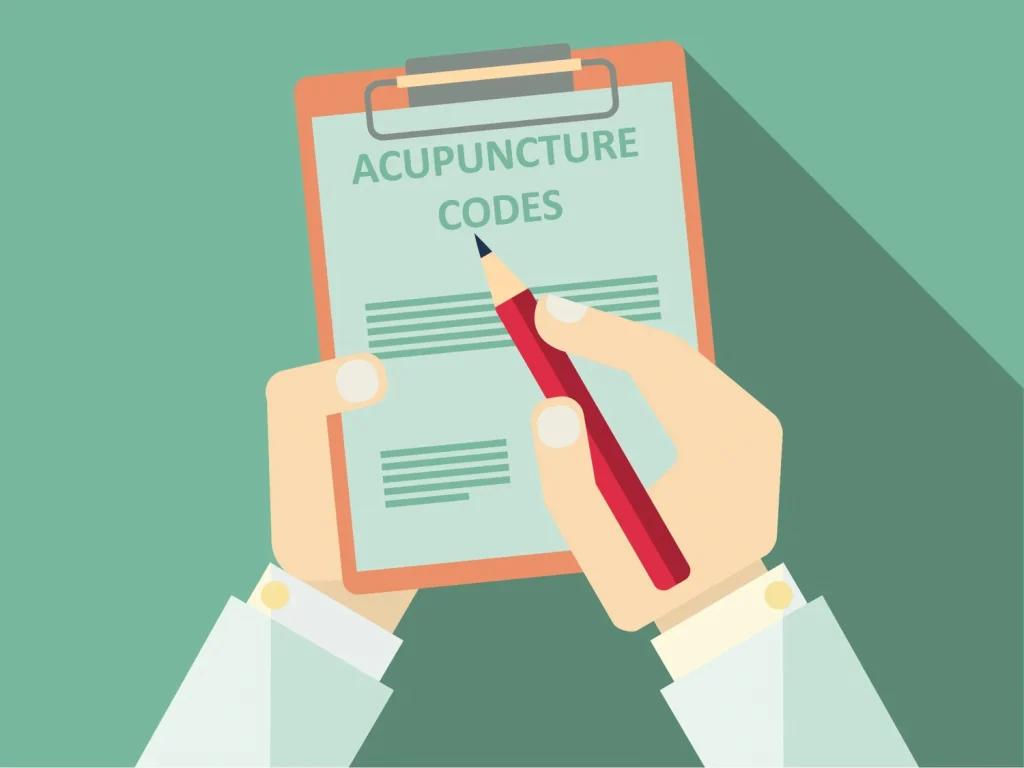


As a billing company focused on holistic healthcare providers, we’ve introduced our share of acupuncturists to the world of billing insurance for acupuncture services. On any given year, roughly half of our new clients will have never billed insurance before they started with Holistic Billing Services, so we are quite accustomed to their most frequently asked questions.
One question that gets frequently asked is “Do you have a list of the codes I can use?” Below is a summary of procedure codes that we feel most insurances will reimburse.
The codes are broken down by the three main sources of revenue for your practice—acupuncture treatments, office visits, and physcial therapy-based treatments and modalities—so we encourage you to keep it handy. Please also keep in mind that your patient’s insurance coverage is determined by the plan and the employer, so it is not enough to just know the insurance company’s name. When you plan to bill insurance for acupuncture, we always recommend that you verify your patient’s insurance benefits directly with the payer before you start treatments.
ACUPUNCTURE TREATMENTS
The bulk of the services you will bill to insurance will likely fall under the four codes below. Acupuncture services are always coded in 15-minute increments. You will use one code for the initial 15 minutes of service and then a separate code for additional units of time. Your codes will only vary if you include electronic stimulation in your treatment. Here is an example of the codes used for a 60-minute visit of acupuncture:
60-Minute Acupuncture Treatment =
1 unit (97810 Initial Acupuncture) + 3 units (97811 Subsequent Unit of Acupuncture)
97810 Initial Acupuncture. Initial 15-minute insertion of needles, personal one-on-one contact with the patient. (Do not report in conjunction with 97813; use one or the other.)
97813 Initial Acupuncture with Electrical Stimulation. Initial 15-minute insertion of needles, personal one-on-one contact with the patient. (Do not report in conjunction with 97810; use one or the other.)
97811 Subsequent Unit of Acupuncture. Use one unit per each additional 15 minutes of personal one-on-one contact with the patient after the initial 15 minutes, with re-insertion of needles. (You may use in conjunction with either 97810 or 97813.)
97814 Subsequent Unit of Acupuncture with Electrical Stimulation. Use one unit per each additional 15 minutes of personal one-on-one contact with the patient, with re-insertion of needles. (You may use in conjunction with either 97810 or 97813.)
OFFICE VISITS
Office visits, otherwise known as evaluation and management services, may be billed on the initial patient evaluation and periodic follow-up evaluations. (A good rule of thumb is every 30 days or every sixth visit.) It is not appropriate to bill these codes every time the patient receives acupuncture treatments, as acupuncture codes 97810, 97813, 97811, and 97814 all include evaluation and management done as part of the overall daily treatment.
Billing a new patient visit code the first time you see a patient is proper using codes 99201 to 99204. A new patient is defined as someone who has not received professional services from you or another provider of the same specialty who has belonged to your practice within the past three years.
99201 Evaluation/Management – Limited. Presenting problems are self-limited or minor: requires a problem-focused history, problem-focused examination, and straightforward medical decision-making. The provider typically spends 10 minutes face to face with the patient.
99202 Evaluation/Management – Expanded. Presenting problems are low to moderate severity; requires an expanded problem-focused history, an expanded problem-focused examination, and straightforward medical decision-making. The provider typically spends 20 minutes face to face with the patient.
99203 Evaluation/Management – Detailed. Presenting problems are of moderate severity; requires a detailed history, a detailed examination, and medical decision-making of low complexity. The provider typically spends 30 minutes face to face with the patient.
99204 Evaluation/Management – Comprehensive. Presenting problems are of moderate to high severity; requires a comprehensive history, a comprehensive examination, and medical decision-making of moderate complexity. The provider typically spends 45 minutes face-to-face with the patient.
An established patient is defined as one who has received any professional services from you or another provider of the same specialty who has belonged to your practice within the past three years. Again, it is inappropriate to bill an established patient visit (codes 99211–99214) on every visit, as your usual acupuncture treatment codes already have a day-to-day evaluation component to assess the progress of your patient.
99211 Evaluation/Management – Minimal. Presenting problems are minimal. The provider typically spends five minutes face to face with the patient.
99212 Evaluation/Management – Limited. Presenting problems are self-limited or minor; requires a problem-focused history, a problem-focused examination, and straightforward decision-making. The provider typically spends 10 minutes face to face with the patient.
99213 Evaluation/Management – Expanded. Presenting problems are of low to moderate severity; requires an expanded problem-focused history, expanded problem-focused examination, and medical decision-making of low complexity. The provider typically spends 15 minutes face to face with the patient.
99214 Evaluation/Management – Detailed. Presenting problem(s) are of moderate to high severity; requires a detailed history, a detailed examination, and medical decision-making of moderate complexity. Providers typically spend 25 minutes face to face with the patient.
PHYSICAL THERAPY-BASED TREATMENTS AND MODALITIES
Acupuncturists use a variety of treatments and modalities to help their patients. These treatments and modalities help strengthen, relax, and heal muscles. Below are a few commonly used by acupuncturists in their daily practice.
20550 Single Injection. Tendon sheath, or ligament, aponeurosis (e.g., plantar ''fascia”).
20552 Injection of One/Two Site Trigger Points. One or two muscles.
97010 Heat Therapy. Application of a modality to one or more areas; hot or cold packs.
97016 Cupping. Vasopneumatic devices. The use may be considered reasonable and necessary for the application of pressure to an extremity for the purpose of reducing edema.
97026 Infrared. The application of infrared therapy is considered medically necessary for patients requiring the application of superficial heat in conjunction with other procedures or modalities to reduce or decrease pain/produce analgesia or reduce stiffness/tension, myalgia, spasm, or swelling.
97110 Therapeutic Exercise. One or more areas, each 15 minutes; therapeutic procedures to develop strength and endurance, range of motion, and flexibility with direct (one-on-one) patient contact.
97112 Neuromuscular Reeducation of movement, balance, coordination, kinesthetic sense, posture, and/or proprioception for sitting and/or standing activities with direct (one-on-one) patient contact.
97140 Manual Therapy techniques such as mobilization and manipulation, manual lymphatic drainage, and manual traction, one or more regions, each 15 minutes with direct (one-on-one) patient contact.
97124 Massage Therapy. Including effleurage, petrissage, and/or tapotement (stroking, compression, percussion) with direct (one-on-one) patient contact.
97530 Kinetic Activities. Use of dynamic activities to improve functional performance, each 15 minutes with direct (one-on-one) patient contact.
Are you interested in learning more about acupuncture billing services?
Here are some additional tips!
And if you are ready to start accepting insurance for acupuncture...



